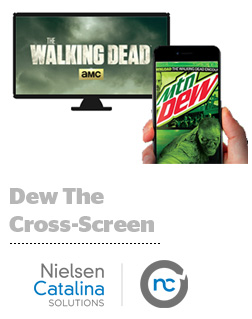
Ad campaigns unfurl across screens, and that’s the way they should be measured.
Nielsen Catalina Solutions (NCS) released a cross-screen measurement tool on Wednesday that links incremental offline sales for an ad campaign to total views across channels, including linear TV, mobile and desktop video, over-the-top (OTT) and connected TV.
NCS, which provides purchase-based targeting and measurement for CPG companies, can also see each platform’s contribution to overall lift.
AMC Networks, Fox and Hulu have tested the solution with CPG clients.
Cross-platform measurement “is crucial in today’s video environment” and brands are increasingly asking for it, said Carolyn Hoffman, director of ad sales research at AMC.
“Client requests depend largely on advertiser KPIs, but more frequently we are hearing a desire for sales lift and return on ad spend, in addition to common metrics like ad recall and purchase intent,” Hoffman said.
To power its solution and measure connected TV, Nielsen Catalina connects household IP addresses, which aren’t considered personally identifiable information in the US, to proprietary NCS identifiers through a partnership with Nielsen Marketing Cloud.
Once that connection is made, NCS can link the connected TV platform with network TV exposures and provide aggregate measurement across linear, digital and connected TV.
Despite some improvements, the lack of a common ID has hampered cross-platform measurement, said Edward Kim, VP of strategy at Nielsen Catalina Solutions.
“People are playing around with different formats, but the reality is that there are no cookie IDs or standard device IDs that everyone can use here as currency or for standardized measurement,” he said.
A lack of holistic audience verification tools also limits an advertiser’s planning capabilities across platforms, said Audrey Steele, EVP of sales research insights and strategy at Fox Networks.
From a sales standpoint, Fox doesn’t have trouble monetizing across screens with different currency solutions for different platforms. The issue is providing clients with defensible proof of performance, Steele said.
“Passive solutions for measuring linear TV and OTT have been limited and inexact in identifying exposure,” she said.
Although linear TV viewing is down and ad sales are hanging on thanks mainly to large CPG advertisers – global annual linear TV ad revenue would be flat without year-end spending on tentpole events – people aren’t watching less content. They’re just engaging with it in more places, Nielsen Catalina’s Kim said.
“Networks, MVPDs, broadcasters – they all acknowledge the fact that viewers are mobile and fragmented, but still watching TV content,” Kim said. “And so they’re seeking ways to provide measurement that enable advertisers to understand return on ad spend and whether it’s higher when they’re placing a commercial on TV or associating that ad with TV-like content across mobile and OTT.”
To support its sponsorship of the eighth season of AMC’s “The Walking Dead,” for example, Mountain Dew wanted to connect sales to an integrated campaign that included “Walking Dead”/Dew packages, an augmented reality app and promos across linear TV, mobile, desktop and AMC’s connected TV app.
The campaign increased incremental sales among exposed households, with 91% coming from previous buyers and 9% from new or lapsed buyers who hadn’t purchased within the past year.
“We’ve conducted other cross-screen survey-based studies in the past, but this is the first time we were able to measure the sales impact of TV, digital and in-app exposure together,” said AMC’s Hoffman. “Client priorities are shifting to keep up with consumer behavior and advertisers are eager to develop 360-degree brand integrations that extend beyond traditional TV.”
This post was syndicated from Ad Exchanger.


More Stories
The NY Post Is Turning First-Party Data Into Direct Deals, With A Little Help From Its Friends
New board member for Blutui
Brave Commerce: Centering the Consumer in the CPG Industry